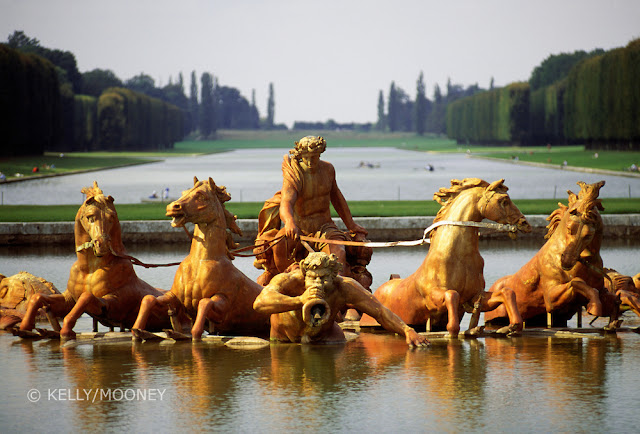 |
| Musee de Antiquities on the ground floor-- Petit Galerie |
 |
| Seven Niche Column Type Sarcophagus (Sculpture on stone coffin), Musee de Antiques |
 |
| Department of Egyptian Antiquities Opened by Jean Francois Champollion |
 |
| Egyptian gods and goddesses of war, Egyptian Antiquities |
In 1800 Napoleon opened Musee de Antiques in the Anne of Austria's apartments. On the ground floor of the petit galerie, a new monumental staircase was set up for the Salon Carre and for the grand galerie separately. In 1824 Musee de Sculpture Moderne was set up on the ground floor of the Cour Carree (square court). In 1826 Jean Francois Champollion, the first curator of the museum, opened the new department of the Egyptian antiquities having nearly 50,000 collections. In 1849 Europe's first museum of Assyrian art was inaugurated in two galleries in the north wing of the Cour Carree. The Mexican, Algerian and ethnographic museums were opened on the ground floor and on the second floor of the pavilion de Beauvais in the north wing of the Cour Carree. During the time of the prince-President Louis Napoleon, three new galleries were opened between 1848 and 1851. During 1852 and 1857 the north wing linking the Louvre and Tuilleries as well as the Cour Napoleon were completed. The Musee de Souverains - the museum exhibiting various collections of royal dynasties- was opened by Louis Napoleon.
 |
| Assyrian Galerie in the north wing of Cour Carree |
 |
| Assyrian Galerie |
 |
| Immortal Archers, Susa Galerie, Iranian Collections by Marcel Dieulaoy |
 |
| Sculpture of the animal Griffin in Susa Galerie |
 |
| Persian lion of Darius of Susa Palace |
 |
| Persian Sculpture |
 |
| Mithra, Persian Sun God, sacrificing a bull |
In 1871 the Tuilleries Palace was burnt down when the revolutionary army attacked. With the demolition of the Tuilleries Palace in 1882, the Louvre Palace became the sole museum of culture and arts. In this museum all rare and valuable artistic and cultural artefacts from all parts of the world are displayed. So many people dedicated their lives to enrich and expand this gigantic museum of museums which has many departments and sections. Marcel Dieulaoy, the French archaelogist, inaugurated the Susa galleries with his rare Iranian collections of art. In 1922 the Islamic arts gallery was opened. In 2012 the new Islamic gallery was opened in the lower ground floor. Between 1932 and 1938 Henri Verne, Director of National Museums, refurbished the galleries of the Egyptian and Near East antiquities. During the second World War (1939-1945) most of the articles were moved to safer Chateaus (castles) and the museum was closed. In 1943 the Musee de la Marine was transferred from the North Wing of Cour Carree(I and II floors) to a wing of the new Palais de Challiot. In 1945 the Asian Collections were moved to the Musee Guimet.
 |
| Statue of Louis XIV, Musee de Souverains |
 |
| Alexander, the Great, Musee de Souverains |
 |
| Musie Guimet, Asian Collections Galerie |
 |
| A Row of Dancers, Musee Guimet |
 |
| Statues of Buddhas, Musee Guimet |
In 1981 President Francois Mitteraand launched the Grand Louvre Project by doubling the museum's exhibition's space to make this palace function as a full-fledged museum. The extension and modernization of the Louvre was entrusted to the eminent Chinese-American architect, Ieoh Ming Pei in 1983. The 21 feet high glass pyramid designed by I.M.Pei was inaugurated on March 30, 1989 adding another marvel to this museum. Rising from the center of the Cour Napoleon this pyramid serves as the focal point of the museum's main axes of circulation leading to various departments. It also serves a grand entrance to the Lounge in the reception hall scattering light through its multi-faceted surfaces as if it symbolizes the universal significance of this museum encompassing all cultures of the world. In 1999 the French President Jacques Chirac announced the creation of a national Museum of Tribal and Aboriginal art on the ground floor of the Pavilion des Sessions.
 |
| Eastern Antiquity Collections |
 |
| Denon Wing with Greek and Roman antiquities |
 |
| Richlieu Wing with the sculptures, porcelain figurines and furniture of Middle Ages |
 |
| Sully Wing with Egypt and Greek works of art along with French Paintings |
This Museum has two satellite museums . The Louvre-Lens is an art museum located in the mining town, Lens, 200 kms north of Paris. With the collaboration of the Japanese Architectural Agency SANAA , the project was started in 2005 to display nearly six hundred works of art. It was opened for public in December, 2012. The Louvre Abu Dhabhi Museum was started in 2007 in Abu Dhabhi, U.A.E. on the Saadiyat island with the collaboration of the local government and it was completed in December, 2015.
Thus the Louvre Museum has established a very fabulous and wonderful institution of global culture accessible to all by having branches in other places and linking the European masterpieces with those of other countries in the world. No wonder then that more than eight million visitors come to this marvellous musuem every year from all parts of the globe.
^^^^^^^^^^^^^^^^^^^^^^^^^^^^^^^^^
8th May, 2016 Somaseshu Gutala



































